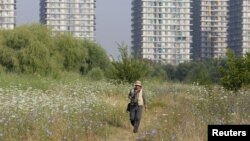On an early morning walk through the Romanian capital's newest park, photographer Helmut Ignat points out cormorants, harriers, terns and several other birds flying high over the marshes.
"We're in luck, all the birds are showing themselves," said Ignat, who discovered Vacaresti park in 2011 on assignment from National Geographic.
Word was beginning to spread that a wild wetland had sprung up between apartment buildings not far from downtown Bucharest.
Ignat is one of four founders of the Vacaresti Nature Park Association, which has spent the last four years lobbying authorities to grant the wetlands protected status.
"We must have met local and central public authorities more than 250 times," said its director Dan Barbulescu.
Advocacy paid off. The government gave Vacaresti protected status in May, one of Europe's largest urban wetlands.
Vacaresti is the result of a communist-era plan to build a lake in southern Bucharest, one of dictator Nicolae Ceausescu's many projects to overhaul the city.
Abandoned in 1989, it was a massive pit surrounded by a concrete embankment that hid it from view.
Nature took over and created 183 hectares (452 acres) of wilderness where experts have identified almost 100 species, including the protected red-breasted geese, egrets, Western marsh harriers, European pond turtles and otters.
"No one was expecting that behind this embankment so many people pass by every day there was such life, a rich, balanced ecosystem," Barbulescu said. "Bit by bit nature has built a place that lives without intervention."
The environment ministry is expected to appoint a park manager by year-end. The association will compete for the job.
The wetlands need protection from trash, fires and poachers.
Squatters need relocation.
A longtime park squatter could become its first ranger, Ignat said. Gigel Enache has been living in Vacaresti for the past 18 years, and he is almost part of the ecosystem.
He arrived with a wife, a four-year-old daughter and a horse and carriage. Now 50, he has nine children aged 4 to 22. They live in improvised huts of cardboard and tarps on the water's edge, without plumbing, steady income or health insurance. The children bubble with excitement and questions around visitors.
Enache used to sell scrap metal for cash and now gives occasional visitors boat rides. He can't afford to move, but even if he could, apartment living is not for him.
"I don't have anywhere else to go, otherwise I wouldn't have lasted here for this long," he said. "But I will die in an apartment building. I am used to being free. I have 18 years of wilderness."







